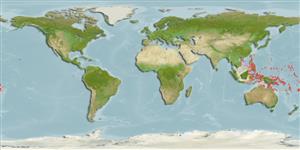Classification / Names
Common names from other countries
Main reference
Size / Weight / Age
Max length : 2.3 cm SL male/unsexed; (Ref. 75094)
Environment
Marine; reef-associated; depth range 6 - 20 m (Ref. 90102)
Climate / Range
Tropical, preferred ?
Distribution
Indo-Pacific: from Christmas Island to Papua New Guinea; north to the Philippines, south to the Great Barrier Reef.
Countries | FAO areas | Ecosystems | Occurrences | Introductions
Short description
Dorsal
soft rays
(total): 8-9;
Anal
soft rays: 6 - 7;
Vertebrae: 33 - 34. Distinguished from its congeners in having the following characters: no stripe on head and dorsal surface of the body; pectoral-fin ray count 23-22; vertebral count 33-34 (Ref. 75094).
IUCN Red List Status (Ref. 115185)
Threat to humans
Harmless
Human uses
More information
Common namesSynonymsMetabolismPredatorsEcotoxicologyReproductionMaturitySpawningFecundityEggsEgg development
Age/SizeGrowthLength-weightLength-lengthLength-frequenciesMorphometricsMorphologyLarvaeLarval dynamicsRecruitmentAbundance
ReferencesAquacultureAquaculture profileStrainsGeneticsAllele frequenciesHeritabilityDiseasesProcessingMass conversion
Tools
Special reports
Download XML
Internet sources
Estimates of some properties based on models
Phylogenetic diversity index
PD50 = 0.6250 many relatives (e.g. carps) 0.5 - 2.0 few relatives (e.g. lungfishes)
Trophic Level
3.1 ±0.3 se; Based on size and trophs of closest relatives
Resilience
High, minimum population doubling time less than 15 months (Preliminary K or Fecundity.)
Vulnerability
Low vulnerability (18 of 100)
Price category
